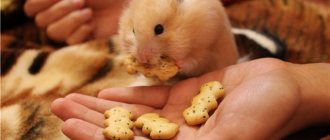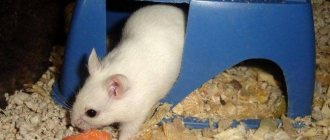Pet sharing is a common theme in animal jokes and videos, but it becomes a problem when one pet turns out to be a predator and the other is its natural prey. In the wild, it doesn’t cost a cat anything to deal with a hamster, because it is capable of killing prey several dozen times more. Therefore, many people are concerned about how strong the hunting instinct is in cats, and whether it is possible to get a rodent.
How do purrs and hamsters get along?
Using a real example, you can learn about all the intricacies of cohabitation between two different pets. Vika from Ukraine says:
https://youtu.be/fzGr7Ostj28
A domestic cat is unlikely to mistake a hamster for hunting prey and will begin to chase it to eat it. Modern cat breeds are too picky about food, some will not even want to eat meat, but only cat food. But the risk is inevitable for a rodent if it can move freely around the apartment, because the cat may mistake the new roommate for another moving toy.
Stories that a cat ate a hamster are often untrue, because in such cases the rodent will be suffocated. The pet will begin to release and catch it, touching it with sharp claws, teeth or pressing it with its paws. He will not be able to “train” instincts in this way on dogs or other pets, but he is quite capable on hamsters.
Search strategy
How to find a hamster in an apartment, using knowledge about some of the habits and habits of these animals? For example, it is known that hamsters are nocturnal animals, that is, at this time their activity increases. If you haven't found it before evening, don't get upset. Most likely, closer to midnight, people will start running around the apartment and then you can quickly notice the loss. But be careful with the rest of the family - don’t accidentally step on the animal. Use a bait trap. Place a few sunflower seeds in some corners of your home - and the rodent will not keep you waiting. If you don't take him by surprise, you'll at least have a rough idea of where the pet is hiding. Of course, if the loss of seeds is not the work of hungry household members.
Or you can be even more cunning - sprinkle the floor around the piles of seeds with flour or starch. Then the white footprints will lead you to the shelter of the lost homa. Another method to find it is to lay foil or other “rustling” material on the floor in the area of the intended hiding places. At night, hide nearby and listen to the surrounding sounds, trying not to make unnecessary movements.
It is necessary to start the search as early as possible in order to avoid injury or death of the homa, because, having climbed somewhere, the animal may get stuck. First, check out the most popular places:
- around the cell;
- under armchairs, sofa, bed, etc.;
- Inspect the boxes, dresser or closet drawers.
If you do not find a fugitive in these places, do not be upset and adhere to these rules:
- Hamsters are active at night; most likely, with the onset of darkness, they will begin to become active, which will help to detect the rodent.
- Leave a crunchy treat in each room (on the floor), the animal will definitely get hungry and, taking the treat, will give itself away;
- Take flour or starch - sprinkle it in front of the entrances to the rooms and in the center of each room. Having poured it in the center of the room, you need to put the goodies in the middle, taking the treat and going back to a secluded place, the hamster will leave behind its paws stained with flour, this will make it easy to detect.
- Instead of flour and starch, you can spread foil or rustling bags in the same places, be sure to put a treat on them: thanks to this method, you will hear rustling noises when the homa comes out of its hiding place for a treat.
- Place your pet's cage on the floor; most likely, after he has had a walk, he will return to his home on his own. Your task is to pour fresh water, add food and leave the doors open. The animal, having heard its native smells, will want to return to its safe home.
- If your homa's home is not a cage, but an aquarium, place it on its side, following the same principle as in the previous paragraph.
How to help a rodent recover from playing with a cat?
But if a dwarf is in the paws of a pet, this does not mean that the cat killed the hamster. The small pet should be removed immediately and the damage inspected. Any wounds from a cat's claws or teeth can be dangerous due to the risk of infection. In addition, the rodent can get sick due to the resulting stress. In such cases it is important:
The small rodent must be protected from contact with the cat.
- Treat wounds with an antiseptic, preferably as painless as possible.
- Take your pet to the veterinarian.
- Create a calm environment for your pet to relieve stress.
- Isolate the hamster.
Djungarik may not recover due to his wounds and repeated stress. Usually, after such incidents, rodents become restless, too mobile and cannot calm down. Veterinarians note that not only small Djungarians suffer from stress, but also large Syrians. They, like purrs, can also have a heart attack from a sense of danger.
Unpreparedness for motherhood
Also, one of the possible reasons why hamsters eat their children is the hamster’s unpreparedness for motherhood.
This is especially common during the first birth. The young hamster does not yet feel ready for childbirth and motherhood. This causes her a lot of stress and can have the unfortunate result that she will eat her young. Interestingly, this usually does not happen during subsequent pregnancies and childbirths. If the female refuses the cubs, you can try to feed them yourself. But you need to look at things realistically and understand that this is a very labor-intensive process that takes a lot of time. Hamsters are fed using a syringe, of course without a needle, or with a pipette
The most important thing is to feed the cubs every 2-4 hours! Are you ready to say goodbye to your usual way of life for three weeks and devote all your time to your kids? You decide
Is it possible to get a hamster if you have a cat?
Although the risk is inevitable, cohabitation of a hamster and a cat in the same house is possible. You just need to introduce them correctly. But the result will depend on the purr’s temperament, because some cats cannot be trained, in particular those brought from the street. Such cats have caught rats and mice, so they will perceive the hamster as prey. If your pet has a naturally aggressive or, conversely, playful character, he will see the rodent as his toy. These breeds include Siamese and Abyssinian breeds. There will be no peace from such cohabitation.
Friendly breeds are rarely dangerous for small neighbors.
Calm purrs, such as the Persian and British, will quickly make friends with the hamster. In addition, it is important to eliminate the risk of conflicts between animals. Cats react very painfully when other animals touch cat food, even if by mistake, or disturb them while resting. Therefore, experienced breeders recommend organizing for each pet an individual place for play, rest, toilet and feeding.
If there is too little space in the house and the animals will constantly overlap, it is better not to get a rodent.
Let's start with the positives
What are the benefits of a hamster as a pet?
Small and convenient
Keeping a hamster does not require much space, and purchasing food and hygienic bedding will not break the budget. Of course, keeping an animal in a three-liter jar is unacceptable, but a relatively small cage of the simplest design will be enough for it.
Caring for a hamster is much easier than other pets. It is enough to wash the cage once a week and change the filler, regularly feed the pet and pour water into its drinking bowl. The hamster eats very little, is not prone to overeating, and always hides some of the food in reserve in its house.
Easily tolerates loneliness
Why is a hamster more convenient than cats and dogs? The hamster does not need to be walked and given a lot of attention. He is not so attached to his owners that he gets bored in their absence, which means he will not “voice” with melancholy when no one is home. Hamsters are generally silent creatures; they squeak only in pain or during fights with their relatives.
If you need to leave home for several days, it is enough to leave the animal with a supply of water and grain mixture. There is no need to ask someone to look after him while you are away.
Funny and harmless
A tame hamster is trusting, calm and rarely shows aggression - that is, you can pick it up and pet it
Yes, he can bite if you carelessly cause him pain or frighten him, but his teeth are not capable of causing serious injury
The hamster is funny. It is interesting to observe his behavior, especially if you equip the cage with a play labyrinth, a house, a running wheel, edible toys, swings, motion counters and similar accessories. In addition, the hamster can be taught simple tricks.
How to make friends with pets?
The best time to accustom a cat to a hamster is when it is only 1-2 months old. At this age, she quickly gets used to another pet. The kitten's claws and teeth are too weak, so even if he tries to grab the hamster, this will not cause any harm to the rodent. It is quite possible to leave a kitten and a hamster alone so that they can build a relationship on their own.
In the case of an adult cat, the situation is more complicated. Leaving animals together, unattended, is initially prohibited. Training is carried out in the usual way: by placing the animals nearby, you need to stop for some time all attempts by the purr to grab the rodent. First it is better to do this with the help of a cage, then without it. Pets should be monitored, as excessive fear of a hamster or excessive aggressiveness of a cat may indicate the impossibility of such “friendship” in the future. Let the pets sniff each other, because smell is an essential link in the pet familiarity chain. Animals must gradually get used to each other. Over time, the cat may even stop reacting to the rodent.
While the animals have not yet become friends, we must remember about precautions. When leaving the house, it is better to lock the cat in a separate room so that he cannot get to the rodent. It is better to hang the cage out of the reach of the mustachioed one, choose a structure with strong bars and a reliable lock. After some time, if the animals begin to react positively to each other, precautions will not be necessary, and the pets will even be able to fall asleep together.
And now the cons
Here's what a future hamster owner should be prepared for:
Sleeps during the day, makes noise at night
The hamster is a predominantly nocturnal animal. This means that in the dark he will actively run around the cage and make noise, and spend most of the day sleeping in his house. Because of these features, you should not place a cage with a hamster in a room that is used for sleeping at night, and it is not advisable to wake up the animal during the day, even if you really want to communicate with it.
This behavior of an animal is dictated by instincts, and it is inhumane to make adjustments to it by forcibly changing its daily routine. The inability to get a good night's sleep has a negative impact on his health and mood.
The owner is not the owner
The hamster's intelligence and emotional sphere are much less developed than those of cats, dogs, parrots and even rabbits. This means that you cannot expect complex emotional reactions and tender affection from the animal, or arrange fun games with it.
If you leave the cage door open, the hamster will probably run away and you will have to search for it for a long time, turning over all the furniture in the apartment. He will not respond to his owner’s call; rather, he will make a “burrow” for himself in the most inaccessible corner of the house, and after 3-4 weeks he will go completely wild.
Gnawing is life
A hamster is a rodent. Its front teeth are constantly growing, so the animal actively grinds them down on all available objects. Therefore, you will have to periodically change all the wooden and plastic elements installed in his cage. And while walking, you need to carefully watch so that he does not chew the wires or spoil the upholstery of upholstered furniture and your clothes with his teeth.
Short life
These rodents do not live long: the maximum lifespan of a Syrian hamster is 6 years, and the age of a Djungarian hamster rarely exceeds 18 months. If you plan to get an animal for a child, you need to be prepared in the event of the pet’s imminent death to console the baby by choosing the appropriate words.
Breeds
Dwarf hamsters come in several breeds, differing primarily in coat color, and are connected by excessive activity.
Dzungarian
The Djungarian hamster is one of the most famous pets of small breeds. The rodent also lives in the wild: on Asian steppe plains and deserts. Representatives of this species are very sociable and partial to attention. Dzhungarik, as he is also called, has thick gray fur with a dark stripe along the entire length of the back, and a white belly. Hamsters weigh only 35–60 grams and measure 5–10 cm.
The animals' low legs are covered with short light hairs, and they also have a tiny tail. The muzzle is slightly elongated, with dark beady eyes. According to color, they are divided into standard (gray-brown with a white belly), sapphire (gray fur with a bluish tint and a white belly), pearl (milky color with streaks of gray tone), tangerine (light brown fur shimmers with a light orange tint).
The lifespan of Djungarian hamsters is from 2 to 4 years, with appropriate care. Representatives of this breed can change color; by winter, their coat becomes lighter. The animals are capable of mating at 4–6 weeks.
In the natural environment, they have offspring from spring to autumn; in a cage they can reproduce all year round. Up to 11 babies appear at a time, pregnancy lasts 21–26 days.
Taylor's Hamster
Taylor's hamster measures no more than 6 cm, although it looks quite plump. The fur is thick, with uneven color: the chest and belly are white, and the head and back are brownish. Tiny ears, also overgrown with fur, are almost invisible, as is the miniature tail. The eyes are black with white eyebrows and spots, the nose is pink. Taylor's hamsters breed all year round.
The duration of the gestation period is about 20–30 days, the offspring ranges from one to five crumbs, weighing only one gram. On the twentieth day, the cubs can live separately. The animals become sexually mature at 10–12 weeks. The life cycle lasts 1.5-3 years.
Campbell's hamster
Campbell's hamster is just one representative of small hamsters, which has different colors: white, black, light brown. The animal's body is round, can reach up to 10 cm in length, weighs approximately 25 g. The tail is very short, the ears are pointed, and the base of the paws is covered with hair. The front legs have 4 toes, and the hind legs have 5. During one pregnancy, at 18–22 days, 4–9 babies appear. A Campbell's hamster lives for 1–2 years.
Roborovsky's hamster
The smallest breed in the world, its representatives measure 4.5-5 cm and weigh 20-25 grams. The fur is fluffy, the tiny tail is completely lost in it. Slightly rounded ears are located on the top of the head, the eyes look like black beads. A special feature of this breed is the presence of white eyebrows. The animals are very jumping, this ability has developed due to the fact that the hind legs are longer than those in front.
Roborovsky's hamsters are classified as hairy-legged, their legs are covered with short hairs. The fur coat is a delicate golden sand color. Varieties with different coat colors have been bred, but you should know that such babies have poor health. One litter can have 3–6 babies. Representatives of this breed live up to 4 years.
Different cats
The domestic cat belongs to the cat family, which has a highly developed hunting instinct. It is believed that cats rush at anything that moves. Is it really? It turns out that a lot depends on the character of the animal, place of birth, and upbringing.
Cats born on the street are always excellent hunters, because their existence depends on it. Hunting for rodents, in most cases, is their only food. If you pick up such a cat and bring it into your home, then be sure to expect trouble. When you see a hamster, the hunter's instinct will definitely awaken in him, even if the animal has lived in the apartment for several years.
There is another type of cat – the mischievous one. They hunt not for food, but for pleasure. It is characteristic that such a cat can be born, raised entirely at home and never experience hunger, and for her tracking a hamster is entertainment. In this case, the cat and the hamster are considered incompatible, and it is better not to leave them alone. It may happen that after strangling the hamster, she will bring it and put it at your feet. Don't punish her. The hunter's instinct tells him to bring the prey to the one whom the cat considers closest. If you hit, you may lose its trust forever, because the offended animal will not understand its guilt. When you see that a hamster and a cat in the same apartment are incompatible, make your choice in favor of one. A rodent may not be able to tolerate constant fear; stressful situations will greatly shorten its short life.
Peace-loving cats. Basically, these are animals raised at home, but there may also be street animals, it’s just that the instinct of pursuit is not developed in them, and hunger is an unknown feeling. Such a couple - a hamster and a cat - easily get along in the same apartment, have the warmest friendships, often play with each other, and can sleep together. It happens that such a cat may be completely indifferent to the appearance of a new resident on his territory and not show any interest in him. Of the purebred animals, this category includes the Persians and the British; they are proud, self-sufficient, and they look at the hamster with contempt. This is also good: you don’t have to fear for the baby’s life.
There is a type of aggressive cat. This includes Siamese and Abyssinian representatives of these breeds. They are distinguished by their wayward character, good hunting instinct, and tenacity. They do not tolerate strangers on their territory and will try to destroy the hamster. If you are the owner of such an animal, then you should not have hamsters.
A good relationship between two animals can develop when you bring a small kitten to the house where the hamster lives. Of course, he will show increased interest in the rodent, smell it, try to touch it, but he will not cause any harm, because, in his opinion, the hamster is the owner of the apartment
As the kitten gets older, he will stop paying attention to him.
The situation is more serious when you bring a hamster into an apartment where another pet already lives. A predator may mistake the rodent for a competitor and try to get rid of it. Or he may enjoy it as entertainment, start hunting for fun, which is also not good.
Breeders often wonder if there are any options for making animals friends? There is no clear answer to this question. It all depends on the character and emotional background of your pet. Hamsters, in turn, have a hard time making contact even with their relatives, prefer to lead a solitary lifestyle, and react hard to attempts to get closer to them.
What to do if living in the same apartment is unavoidable? There are the following recommendations that may help.











